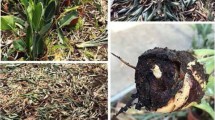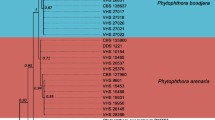Abstract
A new species of the oomycete Aphanomyces mitsuba sp. nov. was isolated from rotting stems and petioles of hydroponically grown mitsuba seedlings. Stem and petiole rot was observed in hydroponic cultivation of “mitsuba”, Cryptotaenia japonica, in Japan. An isolate of Aphanomyces, which has non-septate mycelia and forms bitactic zoospores from filamentous zoosporangia, was obtained from the rotted parts of the plant. In this study, we identified the isolate based on molecular phylogenetic analyses, morphological characteristics, and growth temperature response, and investigated its virulence on “mitsuba”. The rDNA ITS sequence-based molecular phylogenetic analysis showed that the mitsuba isolate was monophyletic and closely related to Aphanomyces iridis. Multigene phylogenetic analysis of the phytopathogenic Aphanomyces species, which was based on the combined sequences of the rDNA ITS region, β-tubulin, cox1, and cox2, also indicated that the mitsuba isolate was located in a monophyletic clade. Morphologically, the isolate is characterized by no-branching, no-tapering zoosporangia, occasionally connected oogonia, and rare coiling of antheridial stalks on oogonial stalks. It is a relatively high-temperature growing species, with an optimum growth temperature of 30 °C, with the capability of growth at 35 °C. The results indicated that the mitsuba isolate is a new species, Aphanomyces mitsuba sp. nov. The new species was pathogenic to “mitsuba”, causing stem and petiole rot and significantly suppressing growth, suggesting that this is a phytopathologically distinct species.






Similar content being viewed by others
Data availability
The datasets generated during and/or analyzed during the current study are available from the corresponding author by request.
References
Becking T, Kiselev A, Rossi V, Street-Jones D, Grandjean F, Gaulin E (2022) Pathogenicity of animal and plant parasitic Aphanomyces spp. and their economic impact on aquaculture and agriculture. Fungal Biol Rev 40:1–18. https://doi.org/10.1016/j.fbr.2021.08.001
Blair JE, Coffey MD, Park S-Y, Geiser DM, Kang S (2008) A multi-locus phylogeny for Phytophthora utilizing markers derived from complete genome sequences. Fungal Genet Biol 45:266–277. https://doi.org/10.1016/j.fgb.2007.10.010
Choi Y-J, Beakes G, Glockling S, Kruse J, Nam B, Nigrelli L, Ploch S, Shin H-D, Shivas RG, Telle S, Voglmayr H, Thines M (2015) Towards a universal barcode of oomycetes – a comparison of the cox1 and cox2 loci. Mol Eco Resour 15:1275–1288. https://doi.org/10.1111/1755-0998.12398
Diéguez-Uribeondo J, García MA, Cerenius L, Kozubíková E, Ballesteros I, Windels C, Weiland J, Kator H, Söderhäll K, Martín MP (2009) Phylogenetic relationships among plant and animal parasites, and saprotrophs in Aphanomyces (Oomycetes). Fungal Genet Biol 46:365–376. https://doi.org/10.1016/j.fgb.2009.02.004
Feng W, Nukaya A, Sato M, Fukuta N, Ishiguro Y, Suga H, Kageyama K (2018) LAMP detection to identify potential contamination sources of plant-pathogenic Pythium species in hydroponic culture systems of tomato and eustoma. Plant Dis 102:1357–1364. https://doi.org/10.1094/PDIS-10-17-1679-RE
Grünwald, NJ (2003) The biology of the genus Aphanomyces. Proceedings of the 2nd international Aphanomyces workshop. 9–14
Ichitani T, Kodama T, Horimoto K (1986) Aphanomyces iridis sp. nov. causing Aphanomyces basal rot of Dutch iris in Japan. Ann Phytopath Soc Japan 52:590–598. https://doi.org/10.3186/jjphytopath.52.590
Levenfors JP, Fatehi J (2004) Molecular characterization of Aphanomyces species associated with legumes. Mycol Res 108:682–689. https://doi.org/10.1017/s0953756204009931
Li M, Ishiguro Y, Otsubo K, Suzuki H, Tsuji T, Miyake N, Nagai H, Suga H, Kageyama K (2014) Monitoring by real-time PCR of three water-borne zoosporic Pythium species in potted flower and tomato greenhouses under hydroponic culture systems. Eur J Plant Pathol 140:229–242. https://doi.org/10.1007/s10658-014-0456-z
Martin FN, Tooley PW (2003) Phylogenetic relationship among Phytophthora species inferred from sequence analysis of mitochondrially encoded cytochrome oxidase I and II genes. Mycologia 85:269–284. https://doi.org/10.1080/15572536.2004.11833112
Morita Y, Tojo M (2007) Modifications of PARP medium using fluazinam, miconazole, and nystatin for detection of Pythium spp. in soil. Plant Dis 91:1591–1599. https://doi.org/10.1094/PDIS-91-12-1591
O’Rourke TA, Ryan MH, Li H, Ma X, Sivasithamparam K, Fatehi J, Barbettiand MJ (2010) Taxonomic and pathogenic characteristics of a new species Aphanomyces trifolii causing root rot of subterranean clover (Trifolium subterraneum) in Western Australia. Crop Pasture Science 61:708–720. https://doi.org/10.1071/CP10040
Pires-Zottarelli CLA, Colombo DRS, Da Paixão SCO, Ventura PO, Boro MC, De Jesus AL (2019) Aphanomyces brasilliensis sp. nov. (Verrucalvaceae, Saprolegniales): a new species from Brazilian Atlantic Rainforest areas. Phytotaxa 415:208–216. https://doi.org/10.11646/phytotaxa.415.4.5
Robideau GP, de Cock AW, Coffey MD, Voglmarr H, Brouwer H, Bala K, Chitty DW, Désaulniers N, Eggerrtson QA, Gachon CMM, Hu C-H, Küpper FC, Rintoul TL, Sarhan E, Verstappen ECR, Zhang Y, Bonants PJM, Ristaino JB, Lévesque CA (2011) DNA barcoding of oomycetes with cytochrome c oxidase subunits I and internal transcriber spacer. Mol Ecol Resour 11:1002–1011. https://doi.org/10.1111/j.1755-0998.2011.03041.x
Takuma D, Sano A, Wada S, Kurata O, Hatai K (2010) A new species, Aphanomyces salsuginosus sp. nov., isolated from ice fish Salangichthys microdon. Mycoscience 51:432–442. https://doi.org/10.1007/S10267-010-0058-3
Tamura K, Stecher G, Kumar S (2021) MEGA11: molecular evolutionary genetics analysis version 11. Mol Biol Evol 38:3022–3027. https://doi.org/10.1093/molbev/msab120
Viljamaa-Dirks S, Heinikainen S (2019) A tentative new species Aphanomyces fennicus sp. nov. interferes with molecular diagnostic methods for crayfish plague. J Fish Dis 42:413–422. https://doi.org/10.1111/jfd.12955
Waterhouse GM (1967) Key to Pythium Pringsheim. Mycol Pap 109:1–15
White TJ, Burns T, Lee S, Taylor J (1990) Amplification and direct sequencing of fungal ribosomal RNA genes for phylogenetics. In: Innis MA, Gelfand DH, Sninsky JJ, White TJ (eds) PCR protocol: a guide of methods and applications. Academic, San Diego, pp 315–322
Acknowledgements
We would like to thank Dr. Noriyuki Miyake (Plant Clinic, Agriculture Support Center, Aichi Prefectural Economic Federation of Agricultural Cooperative) for the statistical analysis.
Author information
Authors and Affiliations
Contributions
KK and HW contributed to the study conception and design. KK wrote a first draft of the article and all the authors commented on previous versions of the manuscript. HW did the field work. KK, KO, AH, and HS did the taxonomical work. Molecular data was obtained by KK, AH, and KO. KK, AH, and HW processed all the figures. KK provided the funding for the project. All authors read and approved the final manuscript.
Corresponding author
Ethics declarations
Ethics approval
Not applicable.
Consent to participate
Not applicable.
Consent for publication
Not applicable.
Conflict of interest
The authors declare no competing interests.
Additional information
Section Editor: Tanay Bose
Publisher's note
Springer Nature remains neutral with regard to jurisdictional claims in published maps and institutional affiliations.
Rights and permissions
Springer Nature or its licensor (e.g. a society or other partner) holds exclusive rights to this article under a publishing agreement with the author(s) or other rightsholder(s); author self-archiving of the accepted manuscript version of this article is solely governed by the terms of such publishing agreement and applicable law.
About this article
Cite this article
Kageyama, K., Watanabe, H., Otsubo, K. et al. Aphanomyces mitsuba sp. nov. causing stem rot of “mitsuba”, Cryptotaenia japonica, in hydroponic culture. Mycol Progress 22, 57 (2023). https://doi.org/10.1007/s11557-023-01908-2
Received:
Revised:
Accepted:
Published:
DOI: https://doi.org/10.1007/s11557-023-01908-2




